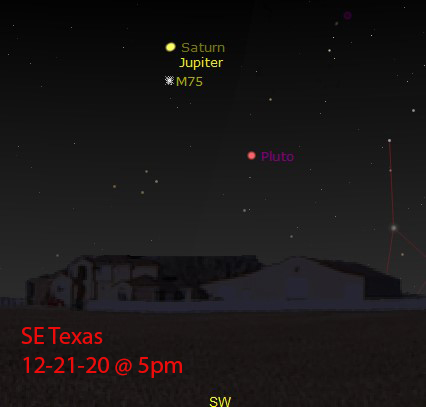By: Jim King

Since ole Charlie Messier is not around to herald the conjunction of Saturn and Jupiter, I thought I would try to fill in the breach with some observing tips and thoughts.
Note of interest: There are those who believe a similar conjunction between Jupiter and Saturn 2,000 – odd years ago, might have been the source of the “Star of Bethlehem” event heralding the birth of Jesus.
As I have pointed out in just about every monthly Messier Column this year in our Houston Astronomical Society newsletter, GuideStar, Jupiter and Saturn will have a dance on December 21, 2020, that is a once in a lifetime event. Some folks believe these planets will merge and appear as a single very bright "star". This may be true if your vision is sub-par. But for those of us with relatively normal vision, we will observe two extremely close-together “stars” – an eye-catching event most of us will never again witness in our entire lives. One should be able to see it with no optical aids.
However, through telescopes using low to medium power (or decent binoculars), those two largest of our local worlds will appear in the same field of view (FOV) – an unforgettable experience. It should be as amazing as the great comet NEOWISE was earlier this year. But be aware, that Saturn’s direction from Jupiter will be at right angles to the Jovian moon system. So, while the ringed planet will appear to come as close to Jupiter as its satellite Callisto regularly does, it will be off in a different direction.
Some important viewing tips: Make sure hills, trees or buildings will not block your view of these planets, which will be low-ish in the southwestern sky. If possible, venture out a few evenings before the conjunction to be sure the planets will be in the clear. If not, find a venue that shows them and plan to be there and ready to observe an hour after sunset on the 21st.
Know what eyepiece or binoculars you will use to place both planets in the same FOV. You will never again get this chance! And importantly, there will not be much time available for tinkering with equipment. That is not hype. Two factors can elevate the event to amazing instead of merely interesting: whether the planets are separated enough from the Sun to be out of the solar glare, and how closely they approach each other in our line of sight. This conjunction will beat all others in the past 100 years hands down. And with the next conjunction in October 2060, the planets will not be nearly as close together. Some of us might miss that one anyway.
So, this is it! Let us hope for clear skies on that day that happens to also be the Winter Solstice. Auspicious? Who knows?


